God’s Global Mission Clarified
Making Sense Out of the Verbiage Surrounding Missions in an Age of Competing Information Marvin J. Newell
Introduction
Many in the pews are confused with the words and terms we so readily throw around in the world of missions. Some verbiage that is common are unreached, unengaged, undiscipled, transformation, unmobilized, penetration, reached, making disciples, world evangelization, unreached peoples, etc. Not only is there confusion as to what is meant, but also by what is important, and what should have priority. The intent of this paper is to bring an order to the strategy of world evangelization, based on what Jesus told us our task is in Matthew 28:19-20. The foundational premise is that Familiarity with Matthew 28:18-20 must dictate mission strategy if we are to clearly understand God’s global mission to the nations, and the corresponding breadth of terminology that is commonly use.
At the outset, some preliminary observations are necessary. First, the over-arching goal of the global mission is world evangelization (Mark 16:15). Notice the magnitude of this goal expressed by two different phrases, "all the world" and "to every creature." The mission of the church is indeed an all-encompassing global task.
Second, the essence of the global mission is to "make disciples of all peoples" (Matthew: 28:18-20). Making disciples entails understanding the 4 spheres of need, the 4 engagement tasks, and the 4 intermediate goals. The spheres of need are best understood by the following configuration or matrix:
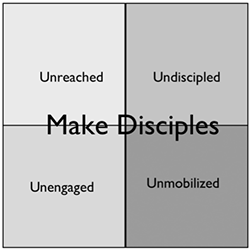
Starting with the bottom left quadrant (unengaged) and moving clockwise from one to the next, the four spheres of need include peoples who are: 1) unengaged, 2) unreached, 3) undiscipled, 4) unmobilized. Each segment represents a specific area of Great Commission concern, represented by a specific quadrant of the overall matrix of "Make Disciples."
The four engagement tasks are represented by a "task continuum bar" that portrays processes critical to making disciples. Those tasks are: penetration, consolidation, transformation, and mobilization. This bar with their corresponding tasks will be noted in the discussion that follows.
The four intermediate goals are sequential and must be achieved one after another. To realize the full continuum of making disciples, people groups must first be engaged, then reached, next discipled, and finally mobilized for outreach
This strategic clarification does not focus on specific ministries that are inclusive and integral to missions. One might ask, "Where is Bible translation, radio, use of internet, mission aviation, gospel recordings, Christian camping, children’s ministries, orality efforts, etc?" These specific ministries are vital to and interwoven within the larger four engagement tasks. However, these should be considered the tactical not strategic level of engagement. More will be said on this later.
If we are to thoroughly fulfill the command to "make disciples of all nations," we must have comprehensive strategic engagement that moves beyond emphasizing one or two aspects of mission concern.
To do that one needs to consider what are the four spheres of need, and what are the necessary engagement tasks to meet those needs.
Unengaged
1) The Unengaged: Defined and Described
The initial phase of making disciples must focus on engaging the unengaged. "Unengaged" means that no one church, no one mission agency, no one person or group of persons have yet taken responsibility to tell a people group of our great God and Savior, Jesus Christ. There presently exist several hundred unengaged people groups at the very heart of the unfinished Great Commission task.(www.finishingthetask.com) Some, like the International Mission Board of the Southern Baptist, put the total number of unengaged groups at over 3,000. These represent thousands upon thousands of unengaged localities and communities.
This term was developed to designate people groups that do not have any active church planting movement occurring within them. According to the IMB Global Research Office: A people group is engaged when a church planting strategy, consistent with Evangelical faith and practice, is under implementation. In this respect, a people group is not engaged when it has been merely adopted, is the object of focused prayer, or is part of an advocacy strategy. (http://public.imb.org/globalresearch/Pages/default.aspx)
2) The Engagement Task: Penetration (reaching out)
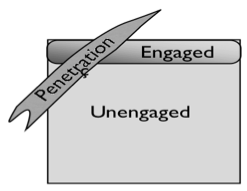
"Penetration" means making a priority of going to those who have had little or no exposure to the gospel.
According to the Tokyo 2010 Declaration, "...messengers go and encounter non-believers by way of personal encounters, broadcasts, podcasts, printed material, recordings, electronic communications, or any other innovative means used as a channel of penetrating witness. Thus, the importance of the ministry of evangelizing." ( http://www.ggcn.org, Tokyo Declaration, page 2)
Therefore, phase one in the engagement task is that of penetration. It is the "going" of Mt. 28:19. It entails the penetration of the gospel into the realm of the unengaged.
3) The Penetrating Process
At least four essential elements constitute effective engagement:
1) Apostolic effort in residence
2) Commitment to work in the local language and culture
3) Commitment to long-term ministry
4) Sowing in a manner consistent with the goal of seeing a church-planting movement emerge (CPM)(http://public.imb.org/globalresearch/Pages/default.aspx)
4) Penetration Delineated
| Activities |
|---|
| Awareness |
| Burden |
| Intercessory prayer |
| Research |
| Selection of focus area |
| Adopting a group Strategizing |
| Team building |
| Partnering (when possible) |
| Entering a focus area |
| Resident in focus area |
| Desired Outcomes |
|---|
| Successful deployment |
| Set-up in focus area |
| Engagement with people |
| Welcomed |
| Earning a hearing |
| Undesired Outcomes |
|---|
| Unsuccessful deployment |
| Rejection – non receptivity Interference causing retreat |
| Intense opposition |
| Deportation |
| Permanent departure |
The remaining unengaged remain so because they are the most difficult to reach.
According to one ministry network, this is the concern: 62% of all Muslim unreached peoples remain unengaged. That means that whatever we are hearing and reporting of God’s stunningly wonderful works among Muslim peoples, we’re not hearing and reporting them among 62% of Muslim unreached peoples.
It is conjectured that 70% of penetrating endeavors to the unengaged are unsuccessful. Some are attempted and end in failure. Others are never attempted at all. Besides the "undesired outcomes" mentioned above, another primary reason is simply the inability of hurdling the barrier of "death by delay." In many cases intentions are noble, but delivery is lacking. Too many ministries focused on the unengaged over dream but under produce.
However, once successful engagement has been realized, the effort moves forward to phase two of making disciples: consolidation of new believers among the unreached who have now been successfully entered and engaged.
Unreached
1) The Unreached: Defined and Described
An unreached or least- reached people is a people group among which there is no indigenous community of believing Christians with adequate numbers and resources to evangelize that people group. It is calculated that there are 6,926 unreached people groups in the world today. Of these about 3,532 are small groups under 10,000 in population and all these groups total less than 8 million individuals.
Joshua Project uses the terms "unreached" and "least-reached" to mean the same thing, thus the terms can be used interchangeably and are both used on their website.
The original Joshua Project editorial committee selected the criteria of less than 2% Evangelical Christian and less than 5% Professing Christians to designate "unreached." While these percentage figures are somewhat arbitrary, there are some who suggest that the percentage of a population needed to influence and impact the whole group is 2%. (The IMB prefers to use this percentage.)
2) The Engagement Task: Consolidation (bringing in)
Consolidation means gathering new believers into a relationship with Jesus and other believers, which is evidenced by the identifying rite of baptism. This is the "baptizing them" of Matthew 28:19. According to the Tokyo 2010 Declaration this is the task of "conserving the fruit of evangelism and then the ability to systematically disciple believers, which takes a local body of believers living in corporate harmony. Thus, the importance of the ministry of establishing churches."(http://www.ggcn.org, Tokyo Declaration, page 2)
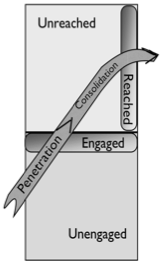
Therefore, the phase two major task of making disciples is that of consolidation. This term represents all that is wrapped up in the "baptizing" of Mt. 28:19. It entails the consolidation of new believers among the unreached into local congregations.
3) The Consolidating Process
At least five essential elements constitute effective consolidation:
1) Continued apostolic effort in residence 2) Effective outreaches that results in bring in new believers 3) Rudimentary teaching on basic Christian doctrine 4) Baptizing new believers as a show of identification with Christ 5) Incorporating believers into local congregations as part of a church-planting movement
4) Consolidation Delineated
| Activities |
|---|
| Intercessory prayer |
| External contextualization |
| Evangelism: "proclamation" |
| Outreach |
| Persuasion |
| Compassion ministries |
| Baptizing new believers |
| Incorporating into body life |
| Church birthing |
| Teaching/nurturing |
| Leadership development |
| Desired Outcomes |
|---|
| Receptive hearts |
| Repentance & belief |
| Marks of salvation |
| Gather with believers |
| Receive "milk of the word" |
| Desire to mature |
| Love other believers |
| Witness to others |
| Fledgling indigenous community of believers |
| Reached! |
| Undesired Outcomes |
|---|
| Resistant hearts |
| Opposition |
| Superficial belief |
| Falling away |
| No church formed |
| No indigenous community |
| No church planting movement |
Once successful consolidation has been realized, the making disciple responsibility moves to phase three: transformation of believers among the reached who remain undiscipled.
Undiscipled
1) The Undiscipled: Defined and Described
The undiscipled are those who claim to be followers of Jesus who may have initially responded positively to and expressed belief in the gospel of Christ, but subsequently have not seriously committed themselves to the life-long process of spiritual maturation and sanctification. One segment of this category may not be followers of Christ at all, but simply "traditional Christians" who describe themselves religiously as Christians (i.e. nominal/cultural Christians). Although empirical data is lacking, it is estimated that there are at least 1.6 billion people who call themselves "Christian" who are undiscipled. They are found worldwide on every continent.
2 )The Engagement Task: Transformation (changing over)

The transformation task involves systematically teaching Christ-followers to observe His commands with the outcome of transformed lives. According to the Tokyo 2010 Declaration, "the new believer’s worldview must be adjusted to a biblical worldview; his lifestyle changed to increasingly conform to the image of Christ; and his ethical conduct progressively marked by biblical morals. Ideally, this results in individuals applying the gospel of the kingdom to every sphere and pursuit of life—from government to economics, from education to health, and from science to creation care. As a consequence whole communities, cultures and countries benefit from the transforming power of the gospel. Thus, the importance of the ministry of teaching." (www.ggcn.org, Tokyo Declaration, page 2)
Therefore, phase three of making disciples involves transformational teaching. It represents all that is intended in the "teaching them to observe all I have commanded" of Mt. 28:20. It entails the transformation of individual lives so they might in turn transform their communities.
3) The Transformational Teaching Process
Greg Ogden states: "Discipling is an intentional relationship in which we walk alongside other disciples in order to encourage, equip and challenge one another in love to grow toward maturity in Christ. This includes equipping the disciple to teach others as well."(Ogden, page 129)
The lack of genuine changed lives has become the greatest omission of the Great Commission the world over. All too often "proselytes" are made instead of "disciples." When this happens churches get filled with bodies that exhibit little evidence of changed beliefs and behaviors. This results in spiritually apathetic adherents who quickly deteriorate into dysfunctional gatherings or nominal Christianity. They easily become victims of aberrant doctrine, heresy and deviant cults. Although they wear the label "Christian" many are not Christ-followers at all. They are superficial followers of "the way" in need of a genuine conversion experience. This sad state has become the bane of the Church the world over. Superficial conversions and inflated statistics only promote non-authentic outcomes.(Newell, page 59)
David Sills warns: If we are not training national believers to believe biblically sound doctrine and to interpret the Word of God correctly, the day will soon come when those who represent Christ in this world will be preaching a gospel that Jesus never gave.
When people wonder what Christianity is about, they will look to a "typical" Christian. The person they look to will not be a Christian in a Western evangelical church preaching a gospel that is orthodox, biblical Christianity will recognize. Doctrinally sound New Testament Christianity is shrinking in size and influence. The bare minimum that missionaries should teach must result in trained leadership in the national church that is able to interpret the Word of God (2 Timothy 2:15), understand basic Christian doctrines (1 Timothy 4:6), and teach them to others (1 Timothy 3:2).10
4) Transformational Teaching Delineated
| Activities |
|---|
| Teaching & preaching |
| Training |
| Mentoring/coaching |
| Nurturing |
| Internal contextualization |
| Discipleship |
| Biblical literacy |
| Theological Education (formal, informal, non-formal) |
| Prayer |
| Leadership training |
| Desired Outcomes |
|---|
| Spiritual maturation |
| Christ-likeness |
| Spirit-filled life |
| Christian worldview |
| Transparent relationships |
| Lordship of Christ |
| Growing sanctification |
| Understanding the Word |
| Priority of prayer |
| Orthodoxy |
| Orthopraxis |
| Undesired Outcomes |
|---|
| Uncommitted |
| Nominalism |
| "Cultural" Christianity |
| Falling away |
| Apostasy |
| Deviant beliefs (cults) |
| Heresy |
| Mere proselytes |
| Dysfunctional gatherings |
| Biblical illiteracy |
| Syncretism |
Paul says succinctly that the goal is "Teaching everyone with all wisdom that we may present everyone mature in Christ." (Col.1:28). Once successful transformation is more and more evident, efforts should move quickly to phase four: the mobilization of believers to reach others who are still unengaged, unreached and undiscipled. The lack of mobilization is indicative of the lack of discipleship.
Unmobilized
1) The Unmobilized: Defined and Described
Unmobilized is that state in visionless churches, where people and resources are not readied for, nor committed to, global outreach so that others may become engaged, reached and discipled. It is a condition where a spirit of self-absorption rather than sacrifice prevails. The task of mobilization can only be done by discipled believers who have a burden for world evangelization. Those who have become mature enough in their faith in Christ to want to share that same faith with others will be willing to ready themselves to propagate their faith.
Some are mobilized as "sent ones" (missionaries) to go to the unengaged, the unreached and the undiscipled. But others - the majority of discipled believers - are mobilized as "senders," the support team that makes the going of sent ones possible. The support team is a vital part of mobilizing for outreach in that it provides the funding, prayer, technical support, moral encouragement, and effective communications necessary to field messengers who are sent.
2) The Engagement Task: Mobilization (thrusting forth)
"Essentially mobilization refers to any process by which God’s people are awakened and kept moving and growing until they find their place for strategic involvement in the task of completing world evangelization."(Winter, page C6)
3) The Process of Mobilizing
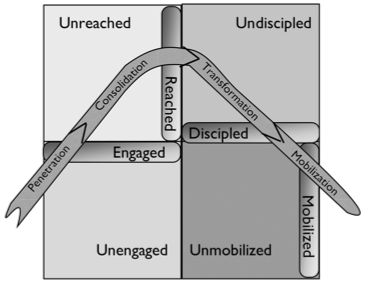
Broadly speaking there are, at minimum, three phases to mobilization:
-
Motivation and inspiration: those who become impacted by God’s mandate to extend his blessing of salvation to all peoples. This may come by way of meeting a missionary, short-term mission trip, reading on missions, mission video, mission conference, etc.
-
Preparation and training:
a) Senders: orientated to the cause of world evangelization either in church or by para-church mission groups.
b) Sent-ones: prepared for cross-cultural mission service by way of a formal, non- formal or informal mission training program. -
On mission: ultimately all who move through the first two phrases ideally become either a sender or a sent one. (Winter, page C6)
4) Mobilization Delineated
| Activities |
|---|
| A vision for the world |
| World needs awareness |
| Mission of God understanding |
| Great Commission familiarity |
| Encourage, enlist, empower workers Prayer for new workers (Mt. 9:27) |
| Instill a personal mission, vision and passion for others |
| Praying, giving, communicating |
| Specifically for sent-ones (Missionaries) |
| Sense of call |
| Surrender of self |
| Selection of focus area |
| Specialized training |
| Partner development |
| Commissioning |
| Going! |
| Desired Outcomes |
|---|
| Declaring the praises of God (1 Peter 2:9) |
| Transmission of gospel |
| Multiplication |
| Reproduction |
| Expansion of church |
| Witnessing |
| Passion that God’s glory be known by all |
| Udesired Outcomes |
|---|
| No burden for the lost |
| No mobilization of people, resources, prayer |
| No action taken to transmit the gospel |
| Apathy toward lost world |
| Self-centeredness |
A fully mission-mobilized church is one that continuously and intentionally harnesses its spiritual capital (prayer, moral support, informed concern), human capital, financial capital, relational capital, and technological capital for making of disciples of all nations. Once this is done, it yields intentional and organized outreach to the three other needy quadrants – the unegaged, unreached, and undiscipled.
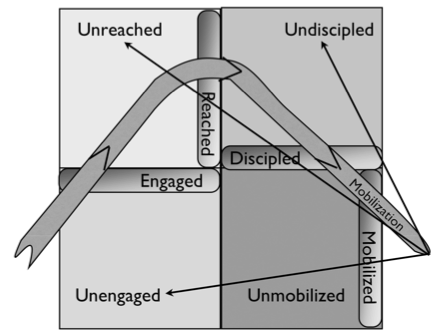
Summing up Making Disciples
Four Essential Tasks of Disciple Making
The Tokyo Declaration states that the depth of the task of making disciples contains three essentials found in Matthew 28:19. The fourth, though not explicit, is strongly implied.
- Reaching out: "Go"
The first essential in making disciples is the going out and encountering those who are not yet Christ followers. They may not yet be Christ followers because they have not yet had the opportunity to hear about Christ. Placed first in the sentence, "Go" is the first step in the disciple making process. It indicates the duty of believers to take the gospel from where it is known and believed to where it is not known nor believed so as to penetrate every people group on earth.
- Bringing in: "Baptizing them"
This second essential is the task of gathering new believers into a relationship with Jesus and other believers, which is evidenced by the identifying rite of baptism. Jesus doesn’t intend the practice of baptism as a magical rite that automatically brings people into relationship with God without a change of heart. Sadly, it has deteriorated into that very thing in some church traditions. Rather, baptism is the culmination of the consolidation process of the repent-believe- baptize experience of salvation.
This public show of initiation is very meaningful for the believer. It is a picture of beginning a new life in Christ and of allegiance to him and to his church. The ordinance is a powerful outward expression of a new identity and a changed life within. Indeed, because of these implications, there are new believers in some hostile cultures who delay its application for fear of repercussion. Antagonistic nonbelievers certainly understand its powerful significance!
- Changing over: "Teaching them to obey"
The making of a disciple does not stop with the initial belief experience nor the subsequent initiation experience. There is an educational process that follows to keep the new believer learning and growing in his/her new faith. Some today would equate this with "spiritual formation." Whatever the label, the important thing is that there be an on-going growth experience. A new believer’s worldview must be changed; his lifestyle adjusted to increasingly conform to the image of Christ; and his ethical conduct increasingly marked by integrity.
Teaching has a final goal – obedience that leads to transformation. New believers are taught with the goal that they become obedient followers of all Christ commanded. Among other things that Jesus taught, they are to live out the great commandment (Mat. 22:37-40) and show great compassion (Mat. 9:36). It takes growth experiences in community with other believers for that to be most effective.
This is why believers are congregated into local churches. This is why missionaries have established Bible schools and seminaries the world over. This is why seminars, webinars, church based training and a host of other teaching ministries are so important. Growth happens best in the presence of other believers. It is the local church that best facilitates the fellowship of believers. Thus, by implication, the establishment of local congregations is an outcome of making disciples.
- Thrusting forth: "All I have commanded you"
There is one final essential to the task of making complete disciples. It is the task of leading believers into their responsibility of being a witness for Christ. Implicit in "all I have commanded you" are the commands of Jesus, given to his disciples, who were to be on mission for Him. This demands total mobilization of a church. He is looking for total engagement by each and every one of us in the Great Commission cause:
He is asking for some to be senders, and others to be sent-ones; some to commit their lives, others to commit of their resources; some to do the work, others to support the work; some to go, others to stay so that the some may go. All must be involved, no one gets an exclusion!
J. Hudson Taylor said, "The Great Commission is not an option to be considered; it is a command to be obeyed."
All four activities – going, baptizing, teaching, and mobilizing – are essential components to "making disciples of every people," and ultimately leading to the over-arching goal of world evangelization. When done correctly, lives are genuinely changed for eternity, which in turn transforms communities.
Therefore, it is incumbent on God’s messengers to engage in these four essential processes in order to make disciples of the nations. Woven together, they make possible reconciliation with God, resulting in transformed lives. Only then do people become genuine disciples of Christ. Only then is the intended outcome of "making disciples" achieved. Only then will sinful societies, corrupt cultures and degenerated communities be transforme. Only then will world evangelization be achieved and God most glorified in all he has created.
Helpful Resources by Category
-
Unengaged
Finishing the Task
IMB Global Research Office -
Unreached
Joshua Project
Peoplegroups.org -
Undiscipled
Church Smart Resources
Desiring God
Global Great Commission Network -
Unmobilized
Missions Catalyst
Perspectives on the World Christian Movement
Finisher’s Project
The Body Builders
Questions Related to the Making Disciples Matrix
-
Which quadrant of the matrix is most important?
Answer: None. All four are equally important. However, one or more may have priority for your ministry. -
Where are tactical ministries in this matrix?
Answer: As previously stated "tactical ministries" such as Bible translation, radio, use of internet, mission aviation, gospel recordings, Christian camping, children’s ministries, orality efforts, are specific ministries vital to and interwoven within the larger four engagement tasks. However, these should be seen on the more tactical level, embedded within a relevant quadrant. The strategic level contains the tactical ministries within them. -
What are the implications for these common statements:
a. "We only support missionaries that work in the 10-40 window."
b. "Latin America is no longer a valid mission field."
c. "We cut out the ‘middle man’ (agencies) to save money."
d. "We don’t support anyone who is assigned to the home office."
(We need to move away from corporate jargon like, "home office" and "the mission headquarters.") -
Each sphere of need demand workers with particular skill sets. Do you know of anyone who is glaringly mis-assigned strategically?
Making Personal/Ministry Application
In light of the clarity that this matrix affords, an individual, church or mission agency should implement a four-step action plan:
-
Plot
A church mission committee should plot on the matrix each one of their missionaries in the quadrant which represents their ministry. -
Pray
Observe the result of what has been plotted. Consider if the results are in line with the missional desire and direction of the church. How balanced do you feel about the distribution of your Great Commission intentions? Take time to pray over the results, asking God if this is the best use of your resources. -
Plan
After taking time to evaluate and pray, plan a course of action. You may not adjust anything, and if so, intentionally affirm what you are already doing. You may discover the need to make an adjustment of resources and emphasis to align with your mission and vision. -
Promote
Publicly promote your vision and commitment to that segment of making disciples ministries that aligns with your purpose. Let others know why you are enthusiastically and passionately engaged in the ministry that you are! Justify it by use of the Making Disciples Matrix. This is your mobilization role to the greater body of Christ.
Dr. Marvin J. Newell is Senior Vice President of Missio Nexus
Bibliography
Newell, Marvin J. Commissioned: What Jesus Wants You to Know as You Go. St. Charles: ChurchSmart Resources, 2010.
Ogden, Greg. Transforming Disciples: Making Disciples a Few at a Time. Downers Grove: Intervarsity Press, 2003.
Sills, David. Reaching and Teaching. Chicago: Moody Publishers, 2010. Winter, Ralph. "The Process of Mobilization" in Mission Mobilizers Handbook.
Pasadena: William Carey Library, 1996. www.finishingthetask.com
www.ggcn.org, Tokyo Declaration, page 2 www.joshuaproject.net/great-commission-statistics.php http://public.imb.org/globalresearch/Pages/default.aspx



